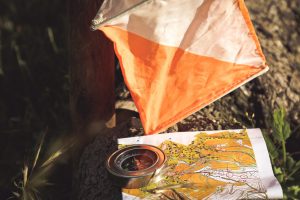Orienteering

Introduction to Orienteering
Orienteering is fun and challenging. With roots in Scandinavia, orienteering is an international sport with world-wide participation. It is the sport of navigating in unknown terrain https://orienteeringusa.org/explore/what-is-orienteering/. Using a map and a compass, participants locate a series of checkpoints called controls. The challenge comes in determining the most efficient route around the course by interpreting land features indicated on the map. It is like a treasure hunt on the run. Pineland Farms has the largest orienteering course in Maine, with 2,500 acres currently mapped, and mapping of the remaining acreage in progress. If you are new to orienteering find more information about skills and basic techniques here: https://orienteeringusa.org/resources/training/ . Our courses are open during the warmer months but may close in winter for the ski season, unless there is a lack of snow. Please call the Outdoor Center at 207.688.6599 for availability.
PRICING:
$5/per person
$8/per person (with a tutorial) call ahead for availability.
For group and team building reservations fill out an inquiry form here. For any other questions please call the Outdoor Center at 207.688.6599
RULES
At a local event, participants copy control points onto their map from a master map. After receiving a control description card and a control punch card, they report to the starting table to begin. The description card identifies the feature where orienteers will find the control at each check point, and the punch card verifies to the officials that the correct control was found. Often, the fastest route between controls is not the shortest route. Finding the best route is part of the fun. Even if you don’t complete a course, it is important to always check in at the finish so that organizers know you are not lost.
For the most success, start with a beginner course and work your way up through the skills. Courses are color-coded to provide beginners to experts with mental as well as physical challenges. Most orienteering meets offer clinics before the competition and will let you try more than one course.
COURSE COLORS
- White: very easy, 1-1.5k in length, usually follows trail
- Yellow: easy, 1-2.5k in length, follows trails with some controls off-trail
- Orange: medium, 2-3k in length, more off-trail controls with route choices
- Red: medium, longer course of 4.5-6k
- Light green: Medium-hard, 3-4k in length, greater use of contours for controls
- Green: Hard, 3.5-4.5k in length, fine compass and contour reading skills required
- Blue: Hard, 4.5-6.5k in length, physically demanding
- Brown: Most difficult, 6.5k or more in length, advanced skills required
GEAR
When you go orienteering, it is important to remember to watch your footing and be aware of your surroundings. You will want to wear long pants if you are trying a course other than white to protect your legs from scratches or scrapes. Trail sneakers or light hiking shoes are good footwear, but don’t be surprised if your feet get wet when you go off-trail. A simple compass is all that is needed to make sure your map is oriented to north. Take along some water and bring a whistle in case you get lost or injured. Remember: Always check in at the finish when you are done.
MAP
Pineland Farms has the largest orienteering course in Maine, with 2,500 acres currently mapped and mapping of the remaining acreage in the progress.